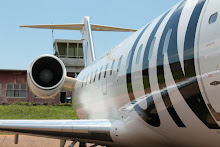Commercial Stage Two
Commercial Multi-Engine is going well. There has been a lot of time spent in the FTD. The school I go to has two Level 6 Seneca FTD's. They are basically Seneca cockpits that have been converted to a computerized simulator with 3 LCD projectors and 3 screens. Having spent some time in an AST HAWK FTD, I can say that the Seneca FTD's are much more realistic. Although I'd always rather be in the plane, I can actually see the value in the Seneca FTD. There are many emergency procedures that are just too dangerous to perform in an actual aircraft. Single engine go-arounds are one that particularly come to mind.
Although FTD's have their gremlins and quirks, they are a decent tool for multi engine flight training. The time I've spent in the FTD has definitely improved memorization of the emergency procedures such as loss of engine during takeoff, engine loss in flight, engine out procedure flows, engine and electrical fires, precautionary engine shut downs, single engine approaches etc.
---
Yesterday was my Commercial Stage 2 check. Most stage checks are 2 part, but commercial stage 2 is 3 part. The first part was a 2 hour oral exam that emphasized aerodynamics, especially Vmc. Other areas were prop and landing gear systems, FAA special emphasis areas and scenario based questions.
Next was 2 hours in the FTD. It was basically 2 hours of the check instructor throwing every type of emergency possible at me.
The final part was 2 hours in a Seneca. It was demonstration of basic maneuvers: slow flight & stalls-clean & dirty, steep turns, emergency descent, Vmc demo, regular and short field takeoffs & landings, complete engine shutdown & restart and single engine instrument approach. It was all pretty smooth, other than the fact that the rudder trim became INOP during the flight. The elevator trim barely worked and took all of my strength to turn the wheel.
The only rough spot was the single engine instrument approach. He failed the left engine 1 mile from the final approach fix and right when Phoenix approach was giving me clearance for the approach and handing me off to Gateway Tower. It took me a little past the final approach fix to get directional control and feather the prop and get stabilized on the glide slope. Vyse is 105 mph and I was having difficulty slowing down, due to the stiff elevator trim. Also, I got a terrible leg cramp due to the rudder trim being out. Holding that kind of rudder pressure for an entire single engine approach is pretty hard! It all worked out. I finally got down to 105 just above DH and landed on the 1000' markers. My right leg was numb from the pain. The first thing I did was squawk the trim.
A few guys have busted stage 2 recently and I was a little nervous. It felt good to pass. On to stage 3 which takes me to the end of commercial multi engine. Stage 3 consists of a ton of instrument approaches and about 20 hours of day and night long distance cross country flying. I'm looking forward to that.
The remainder of Commercial consists of: Stage 3, end of course, part 142 multi engine FAA check ride and then single engine add-on check ride. I hope to be done with commercial before the 15th of December...depending on aircraft down time and availability.

No comments:
Post a Comment